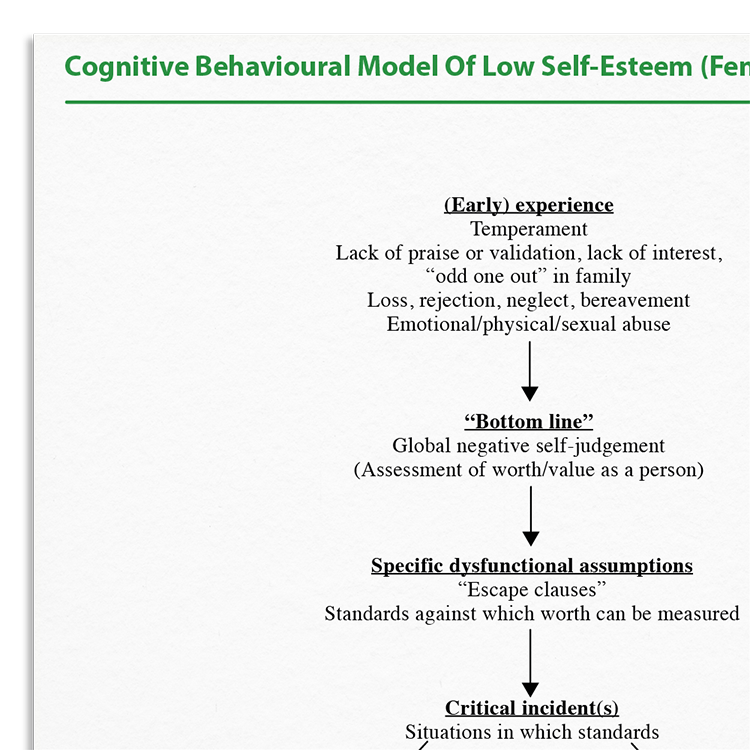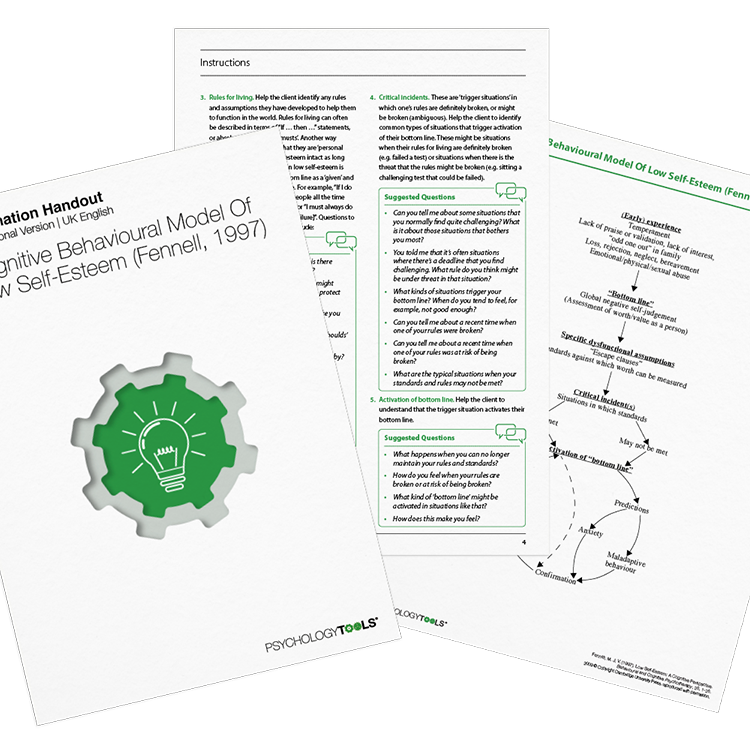Professional version
Offers theory, guidance, and prompts for mental health professionals. Downloads are in Fillable PDF format where appropriate.
A licensed copy of Fennell's (1997) cognitive behavioral model of low self-esteem which describes a framework to address the core components and low self-esteem.

Offers theory, guidance, and prompts for mental health professionals. Downloads are in Fillable PDF format where appropriate.

Fennell's Cognitive Behavioral Model Of Low Self-Esteem (1997) offers a framework for understanding how negative self-evaluations become ingrained and persist. It explains how early life experiences contribute to self-beliefs, and how these beliefs are maintained by cognitive biases and unhelpful patterns of behavior. Clinicians can use this model to guide for case formulation, and to identify treatment for improving self-esteem.
Understanding the cognitive underpinnings of low self-esteem is important for effective intervention.
Formulating interventions for pervasive negative self-beliefs.
Where low-self esteem is comorbid with depression.
Addressing self-critical thoughts and avoidance behaviors.
Understand more about the cognitive behavioral model of low self-esteem.
Use the model as a template to organize your case formulations.
Use your knowledge of the model to explain maintenance processes to clients.
Engage clients in discussions about their beliefs and behaviors.
Customize interventions based on individual maintenance mechanisms.
Use in supervision to discuss formulation and treatment plans.
Fennell’s model extends Beck’s cognitive theory by describing how negative beliefs about the self develop and persist over time. Early life experiences — particularly those involving criticism, neglect, or conditional approval — can lead people to form global negative beliefs such as “I am worthless” or “I’m not good enough.” These beliefs often remain dormant until triggered by relevant life events, at which point they become activated and shape how the individual interprets themselves, others, and the world.
Once established, negative self-beliefs are maintained by a range of cognitive and behavioral processes. Individuals tend to interpret information in a biased way, giving more weight to experiences that confirm their negative beliefs while dismissing evidence to the contrary. In an effort to protect themselves, they may also develop rules for living or coping strategies — such as avoidance, perfectionism, or appeasement — which offer short-term relief but ultimately reinforce the original beliefs. These patterns create a self-perpetuating cycle in which low self-esteem is preserved.
Therapeutically, the model provides a structured framework for helping clients understand how their self-view has developed and why it persists. It invites collaborative exploration of early experiences, core beliefs, and the day-to-day strategies that keep those beliefs in place. Interventions typically involve helping clients notice and challenge automatic thoughts, experiment with alternative ways of behaving, and develop a more compassionate and balanced view of themselves. The goal is not simply to eliminate negative beliefs, but to broaden the client’s perspective and develop a more flexible, accepting self-concept.

Just enter your name and email address, and we'll send you Cognitive Behavioral Model Of Low Self-Esteem (Fennell, 1997) (English US) straight to your inbox. You'll also receive occasional product update emails wth evidence-based tools, clinical resources, and the latest psychological research.
Working...
This site uses strictly necessary cookies to function. We do not use cookies for analytics, marketing, or tracking purposes. By clicking “OK”, you agree to the use of these essential cookies. Read our Cookie Policy